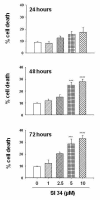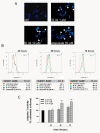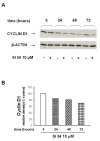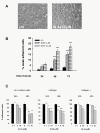Antiproliferative and pro-apoptotic effects afforded by novel Src-kinase inhibitors in human neuroblastoma cells
- PMID: 21050441
- PMCID: PMC2992519
- DOI: 10.1186/1471-2407-10-602
Antiproliferative and pro-apoptotic effects afforded by novel Src-kinase inhibitors in human neuroblastoma cells
Abstract
Background: Neuroblastoma (NB) is the second most common solid malignancy of childhood that usually undergoes rapid progression with a poor prognosis upon metastasis. The Src-family tyrosine kinases (SFKs) are a group of proteins involved in cancer development and invasiveness that seem to play an important role in the NB carcinogenesis.
Methods: To determine cell proliferation, the growth rate was evaluated by both MTT test and cells counted. Analysis of DNA content was performed for the evaluation of the cell cycle and apoptosis. To characterize the mechanisms underlying the antiproliferative effects induced by SI 34, a novel pyrazolo-pyrimidine derivative provided with Src inhibitory activity, the involvement of some cellular pathways that are important for cell proliferation and survival was investigated by western blot assays. In particular, the contribution of cyclins, Src and ERK were examined. Finally, experiments of cell adhesion and invasiveness were performed.
Results: Treatment of SH-SY5Y human NB cells and CHP100 human neuroepithelioma (NE) cultures with three novel pyrazolo[3,4-d]pyrimidine derivatives, namely SI 34, SI 35 and SI 83, inhibits the cell proliferation in a time and concentration-dependent manner. The maximal effect was obtained after 72 hours incubation with SI 34 10 μM. Fluorescence microscopy experiments, flow cytometry analysis and determination of caspase-3 activity by fluorimetric assays showed that SI 34 induced SH-SY5Y apoptosis. Moreover, SI 34 determined cell cycle arrest at the G0/G1 phase, paralleled by a decreased expression of cyclin D1. Furthermore, our data indicate that SI 34 reduces the SH-SY5Y cells adhesion and invasiveness. Evidence that SI 34 inhibits the Src and the ERK-phosphorylation, suggests the mechanism through which it exerts its effects in SH-SY5Y cells.
Conclusions: Our study shows the ability of this pyrazolo-pyrimidine Src inhibitor in reducing the growth and the invasiveness of human NB cells, suggesting a promising role as novel drug in the treatment of neuroblastoma.
Figures








Similar articles
-
Efficient optimization of pyrazolo[3,4-d]pyrimidines derivatives as c-Src kinase inhibitors in neuroblastoma treatment.Bioorg Med Chem Lett. 2018 Nov 15;28(21):3454-3457. doi: 10.1016/j.bmcl.2018.09.024. Epub 2018 Sep 20. Bioorg Med Chem Lett. 2018. PMID: 30262428
-
Src kinase family inhibitor PP2 induces aggregation and detachment of neuroblastoma cells and inhibits cell growth in a PI3 kinase/Akt pathway-independent manner.Pediatr Surg Int. 2011 Feb;27(2):225-30. doi: 10.1007/s00383-010-2775-2. Pediatr Surg Int. 2011. PMID: 21046121
-
New pyrazolo[3,4-d]pyrimidine SRC inhibitors induce apoptosis in mesothelioma cell lines through p27 nuclear stabilization.Oncogene. 2012 Feb 16;31(7):929-38. doi: 10.1038/onc.2011.286. Epub 2011 Jul 25. Oncogene. 2012. PMID: 21785466
-
TRAIL induces pro-apoptotic crosstalk between the TRAIL-receptor signaling pathway and TrkAIII in SH-SY5Y cells, unveiling a potential therapeutic "Achilles heel" for the TrkAIII oncoprotein in neuroblastoma.Oncotarget. 2016 Dec 6;7(49):80820-80841. doi: 10.18632/oncotarget.13098. Oncotarget. 2016. PMID: 27821809 Free PMC article.
-
Vincristine induces cell cycle arrest and apoptosis in SH-SY5Y human neuroblastoma cells.Int J Mol Med. 2013 Jan;31(1):113-9. doi: 10.3892/ijmm.2012.1167. Epub 2012 Oct 30. Int J Mol Med. 2013. PMID: 23129065
Cited by
-
A New Strategy for Glioblastoma Treatment: In Vitro and In Vivo Preclinical Characterization of Si306, a Pyrazolo[3,4-d]Pyrimidine Dual Src/P-Glycoprotein Inhibitor.Cancers (Basel). 2019 Jun 19;11(6):848. doi: 10.3390/cancers11060848. Cancers (Basel). 2019. PMID: 31248184 Free PMC article.
-
Mechanisms underlying the anti-tumoral effects of Citrus Bergamia juice.PLoS One. 2013 Apr 16;8(4):e61484. doi: 10.1371/journal.pone.0061484. Print 2013. PLoS One. 2013. PMID: 23613861 Free PMC article.
-
Synthetic Heterocyclic Derivatives as Kinase Inhibitors Tested for the Treatment of Neuroblastoma.Molecules. 2021 Nov 23;26(23):7069. doi: 10.3390/molecules26237069. Molecules. 2021. PMID: 34885651 Free PMC article. Review.
-
Src Inhibitors Pyrazolo[3,4-d]pyrimidines, Si306 and Pro-Si306, Inhibit Focal Adhesion Kinase and Suppress Human Glioblastoma Invasion In Vitro and In Vivo.Cancers (Basel). 2020 Jun 14;12(6):1570. doi: 10.3390/cancers12061570. Cancers (Basel). 2020. PMID: 32545852 Free PMC article.
-
Synthesis and biological properties of 5-(1H-1,2,3-triazol-4-yl)isoxazolidines: a new class of C-nucleosides.Molecules. 2015 Mar 24;20(4):5260-75. doi: 10.3390/molecules20045260. Molecules. 2015. PMID: 25812148 Free PMC article.
References
Publication types
MeSH terms
Substances
LinkOut - more resources
Full Text Sources
Other Literature Sources
Medical
Research Materials
Miscellaneous

